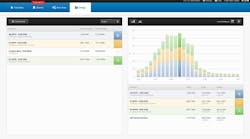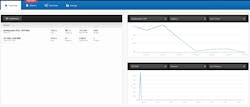Energy use in the industrial sector accounts for half of the world's energy consumption, according to the U.S. Energy Information Administration's "International Energy Outlook 2013." Industrial facilities are also responsible for 20% of U.S. greenhouse gas emissions, according to the Environmental Protection Agency's Inventory of U.S. Greenhouse Gas Emissions and Sinks: 1990-2011 (April 2013). As energy demand continues to grow, finding efficiencies in the way we use power is crucial.
Electrical management programs help control costs and reduce energy requirements while improving system reliability and enhancing workplace safety. Further, these initiatives are helping to control and reduce greenhouse gas emissions. Energy and carbon management programs are important to business’ profitability, and the first step is monitoring.
Why does monitoring matter?
Many facilities do not properly monitor resource usage, and those that do often use outdated monitoring and management hardware and software platforms. By installing or upgrading power and energy metering devices and electrical power management systems (EPMSs), facility management can accurately manage, analyze, and trend electrical availability and power usage.
When modern metering solutions are combined with EPMS, a dashboard view across an entire enterprise is provided, along with the intelligence required to identify inefficiencies and target upgrades in a cost-efficient manner, while lowering operational costs and preventing equipment downtime in the process (Figure 1).
Figure 1. Electrical power management systems provide a dashboard view across an entire enterprise, along with the intelligence required to identify inefficiencies and target upgrades in a cost-efficient manner.
Power systems are a critical, integral part of any organization’s technological infrastructure. Ensuring availability, efficiency, and reliability and reducing the carbon footprint is high on any priority list. To achieve this, sophisticated data gathering and analysis is a must.
Modern power monitoring and management systems simplify facilities management by bringing electrical equipment, such as switchgear, automatic transfer switches, panelboards, and motor control centers onto the network. With the addition of energy meters, or by using the utility’s meters, gateways, and software solutions, customers can enable detailed energy use tracking — delivering the resources needed to seamlessly bring facility assets together for end-to-end system reliability and efficiency.
Evolution of BMS systems
Traditionally, building management systems (BMSs) were not intended to provide a holistic view of building performance and efficiency. Rather, they provided insight into individual aspects of a facility. Enterprise software companies applied information and communication technology to the problem of managing, mitigating, and optimizing energy, natural resources, and greenhouse gases at large institutional, government, commercial, and industrial-scale facilities.
Today, BMS can connect to third-party systems with databases that apply analytics to yield a dashboard that facility managers or financial managers use to get a holistic view of energy consumption, efficiency, and greenhouse gas emissions. In turn, that energy dashboard is providing the intelligence that energy services teams are using to help building owners meet energy efficiency and sustainability goals.
Enterprise software companies typically offer an enterprise software platform for managing energy usage and sustainability data through a managed service plan. Further, these companies are also strategically aligning with organizations able to deliver the energy engineering services necessary to design and implement an energy and data management solution across the enterprise with the on-the-ground support and extensive experience successfully implementing similar projects.
Software and engineering service companies are also providing the solution that serves as the base platform for integrating with third-party control systems such as BMS and lighting controls for collecting and transmitting energy usage information to the enterprise software where analytics will be applied.
A unified view
By integrating EPMS with BMS, facility personnel can monitor and manage mechanical system and power systems across an entire facility. The integrated platform will collect information from infrastructure pieces, including HVAC, UPS, power distribution systems such as meters, motor control, and variable frequency drives, as well as generators, fire-detection equipment, security systems, and other communication subsystems all on one screen.
High-performance analytics provide the ability to find and quantify the financial impact of operational issues. Analytics play a pivotal role in discovering where there is significant energy waste. Further, by quickly and efficiently analyzing individual building systems as an integrated strategy, analytics help to reduce the amount of time and money spent monitoring and investigating building operations. Fundamentally, analytics help to automate and simplify the processes to improve energy efficiency by looking at and analyzing data across a facility or enterprise.
Figure 2. High-performance analytics help building owners to track, manage, and reduce energy, water, and resource consumption, waste and emissions, and to forecast future use.
Armed with these real-time analytic capabilities, building owners are better positioned to manage energy usage, improving efficiency, avoiding downtime, and improving sustainability (Figure 2). More specifically, analytics help building owners to:
- track, manage, and reduce energy, water, and resource consumption, waste and emissions, and forecast future use
- plan, execute, and track financially optimized strategies for mitigating energy, water, and resource consumption, waste and emissions
- reduce exposure to energy price volatility and minimize energy purchase prices through intelligent forward contract purchases that are based on accurate forecasts of needs
- monetize energy and resource reductions through the creation and trading of environmental assets such as certified emissions reductions (CERs) and renewable energy credits (RECs)
- extend these capabilities beyond their internal operations to their supply chains and trading partner networks
- comply with environmental regulatory and voluntary reporting requirements
Simplified data collection
At the root of a comprehensive energy management program are gateways, which bring diverse power components into a system that can be monitored and managed. They collect data from serial communicating monitoring devices and other intelligent electronic motor control and power distribution components.
Gateways enable quick access to the data monitored by meters and other devices, so that users and OEMs can see what is happening without having to log the data from the meter manually. Gateways collect and consolidate that key data for real-time viewing and log historical data to generate reports. Fundamentally, the gateway provides a way to collect electrical parameters and aggregate data from electrical equipment like meters, relays, and circuit breaker trip units into a system that can be monitored and managed. Further, gateways can also provide alarms and event status on communications, over- and under-voltage or current, and other available alarms from serial devices.
With plug-and-play functionality, gateways provide small systems with a stand-alone solution to log and trend power data without the need for additional software. Gateways also serve as a data collection point for multiple devices in larger systems with remote locations and work seamlessly with electrical monitoring systems in an expandable solution that can be customized for buildings of any size.
Gateway devices have been around for about a decade, and there is a range of models available, giving the users the flexibility to select the feature options to meet their needs for power and energy monitoring. It is important to look for devices that can collect data from various manufacturers, as most systems include equipment from multiple manufacturers. Gateways should also use open protocols that enable communications with devices that communicate via an open protocol like Modbus, regardless of the manufacturer.
By combining modern gateway and energy management solutions, facilities can achieve a comprehensive view into energy usage from a central location, without the need for extensive programming or training (Figure 3).
Figure 3. By combining modern gateway and energy management solutions, facilities can achieve a comprehensive view into energy usage from a central location.
Significant opportunities exist to realize energy cost reductions in your plant or facility, assuming you have state-of-the-art products in place to assure accurate energy use measurement and verification.





